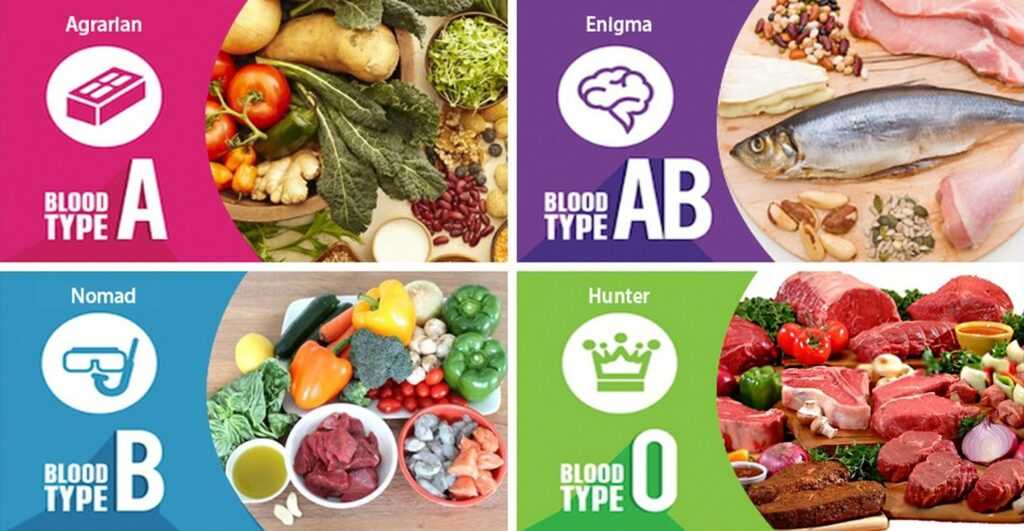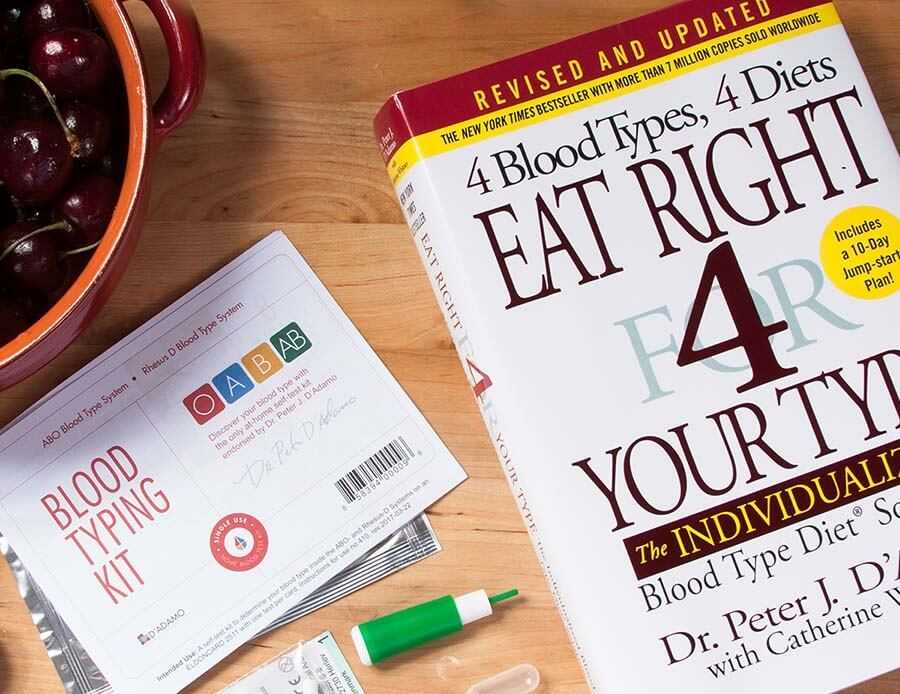In 1996 a book titled “Eat Right 4 Your Type” was published by Dr. Peter D’Adamo in which he proposed a link between ABO blood group and diet. This was the starting of the self-made nutrition theory, which led to the foundation of the Blood-Group type diet, or as the name suggests, that one should eat according to their blood type.

The book became a New York Times bestseller, and was translated into 60 languages and went on to sell over seven million copies worldwide, and still counting. It was, and is still a hot concept, promoted by lot of celebrities, self-proclaimed nutritionists, dieticians and fitness coaches.
Renown author and nutritionist Dr. Edward Blonz, Ph.D. in nutrition, suggested that, the concept of blood type originated in the early years of this century with German pathologist Karl Landsteiner. He identified two proteins, or antigens, that he found on the surface of the red blood cell. Calling these antigens A and B, Landsteiner proceeded to describe four blood groupings, A, B, AB, and O, according to whether they had one or the other, or both, or neither. Since then we’ve learned that type A’s can have either AA genes or AO genes, B’s can be BB or BO, ABs have to be AB, and O’s have to be OO. The genes for these proteins are passed to us from our parents. Landsteiner didn’t know it at the time, but the ABO identification system was only the start. In the years since his pioneering work, 276 discrete red-cell antigens have been discovered.
Acc. to Dr. Blonz, D’Adamo, unfortunately, offers little in the way of scientific evidence, relying instead on a collection of anecdotal reports and case histories. His speculation that the one gene responsible the ABO blood type could exert such a dominant influence over everything else is unable to stand on its own merits.
Acc. to a 2013 study, certain consistent and inconsistent studies, have shown that, a number of associations between ABO blood type and certain diseases, including pancreatic cancer, venous thromboembolism, and myocardial infarction in the presence of coronary atherosclerosis. Therefore, it appears possible that the ABO blood group system plays a role in determining an individual’s susceptibility to certain diseases. This established association between blood types and disease has been translated into the basis for a range of diets.
Researchers suggested that, acc. to D’Adamo each ABO blood type processes food differently, and adherence to a diet specific to an individual’s ABO blood group could improve health, wellbeing, and energy levels and reduce risk of developing diseases such as cancer and cardiovascular disease. D’Adamo diets, one for each ABO blood type, are based on a theory that each blood type contains the genetic message of the diets and behaviours of our ancestors, and these traits still have an impact on us today.
Acc. to a 2014 study, based on the ‘Blood-Type’ diet theory, group O is considered the ancestral blood group in humans so their optimal diet should resemble the high animal protein diets typical of the hunter-gatherer era. In contrast, those with group A should thrive on a vegetarian diet as this blood group was believed to have evolved when humans settled down into agrarian societies. Individuals with blood group B are considered to benefit from consumption of dairy products because this blood group was believed to originate in nomadic tribes. Finally, individuals with an AB blood group are believed to benefit from a diet that is intermediate to those proposed for group A and group B.

In the book, D’Adamo describes 4 different diets, one for each blood group:
Type A: The agrarian or cultivator. Blood type A people who should eat plant rich diets with no red meat. They should choose fruit, vegetables, tofu, seafood, turkey, and whole grains but avoid meat. For weight loss, seafood, vegetables, pineapple, olive oil, and soy are best; dairy, wheat, corn, and kidney beans should be avoided.
Type B: The nomad. People with blood type B should eat plants, and can eat meat (except chicken and pork), and some dairy. To lose weight, type B individuals should choose green vegetables, eggs, liver, and licorice tea but avoid chicken, corn, peanuts, and wheat.
Type AB: The enigma. This person is a ‘mix’ between types A and B, and should eat a diet rich in seafood, lamb, tofu, dairy, beans and grains, fruits and vegetables. For weight loss, tofu, seafood, green vegetables, and kelp are best but chicken, corn, buckwheat, and kidney beans should be avoided.
Type O: The hunter. People with blood type O should eat high protein diets that are rich in meat, fish, poultry, some fruits and vegetables, but limit grains, legumes and dairy. To lose weight, seafood, kelp, red meat, broccoli, spinach, and olive oil are best; wheat, corn, and dairy are to be avoided.
In fact, the spices used in food, the exercise to be performed, should all depend on the blood group, according to D’Adamo. For example, people with type O blood are advised to choose high-intensity aerobic exercise and take supplements for their sensitive stomachs, while those with type A blood should choose low-intensity activities and include meditation as part of their routine. The best part, there are millions who have read it, and take this diet as the gospel for their good health.
The book and website are full of such baseless, self-made claims, based purely on anecdotal evidences. Initially it was just the diet, but now there are a host of blood-group type supplements out there: blood type probiotic formulas, blood type mineral and vitamin formula, blood type protein bars and shakes, anti-stress supplements for specific blood types, vision support and memory enhancement supplements, detoxification supplements, and even blood group type herbal teas, to name a few.
So, blood group type is not just a diet anymore, but a full-fledged nutrition company selling you a host of products, matching your blood group.
LET’S DEBUNK THIS DIET
- A 2013 study, identified and analyzed studies which presented data related to blood-group type diet. They found that, no studies have been performed to specifically examine resulting health effects. This situation is despite it being mentioned within D’Adamo’s books (published in 1996 and 2004) that ABO blood type diet trials were expected to be completed within 2y and 12wk, respectively.
Researchers found that, evidence exists that links an increased vulnerability of certain blood types to particular diseases, and studies that considered an association between genetic variation and responses to specific diets are also available.
However, there is currently no evidence that an adherence to blood type diets will provide health benefits, despite the substantial presence and perseverance of blood type diets within the health industry.

2. A 2014 study, determined the association between ‘blood-type’ diets and biomarkers of cardio-metabolic health and whether an individual’s ABO genotype modifies any associations. They took 1,455 subjects (993 women and 462 men) participants of the Toronto Nutrigenomics and Health (TNH) Study, which is a cross-sectional examination of young adults aged 20 to 29 years. Dietary intake was assessed using a one-month, 196-item food frequency questionnaire and a diet score was calculated to determine relative adherence to each of the four ‘Blood-Type’ diets.
Researchers found that, adherence to certain ‘Blood-Type’ diet is associated with favourable effects on some cardio metabolic risk factors. For e.g. adherence to the Type-A diet was associated with lower BMI, waist circumference, blood pressure, serum cholesterol, triglycerides, insulin etc. Adherence to the Type-AB diet was also associated with lower levels of these biomarkers, except for BMI and waist circumference. Adherence to the Type-O diet was associated with lower triglycerides.
But these associations were independent of an individual’s ABO genotype, so the findings do not support the ‘Blood-Type’ diet hypothesis.
Acc. to Dr. Robert Shmerling, associate physician and clinical chief of rheumatology at Beth Israel Deaconess Medical Centre and an associate professor in medicine at Harvard Medical School; “Type O was said to be the original “ancestral” blood type of the earliest humans who were hunter-gatherers, with diets that were high in animal protein. Group A was said to evolve when humans began to farm and had more vegetarian diets. Group B blood types were said to arise among nomadic tribes who consumed a lot of dairy products. And since Group AB blood was supposed to have evolved from the intermingling of people with types A and B blood, type AB recommendations were intermediate between those for people with types A and B blood.
Each of these theories has been challenged. For example, there is evidence that type A was actually the first blood group to evolve in humans, not type O. In addition, there is no proven connection between blood type and digestion. So, in addition to a lack of evidence that the diet works, serious questions remain about why it should work in the first place.”
3. A 2018 study, examined the validity of blood-group type diet in overweight adults. A total of 973 adults [758 women, 215 men] were participants of the Toronto Healthy Diet Study, who followed the blood-group type diet.
Researchers found that, individuals with a higher adherence score to the type A diet had lower diastolic blood pressure. Lower waist circumference was observed in individuals with higher adherence to the type B and type AB diets. After a 6-mo dietary intervention, individuals with increased adherence to the type A and type B diets had greater reductions in BMI and waist circumference, respectively. Individuals with an increase in type O diet adherence showed decreases in both BMI and waist circumference.
However, matching the diets with the corresponding ABO genotype of each individual did not change the effect size of any of these associations either at baseline or at 6 mo. ABO genotype does not modify any association between blood-type diets and biomarkers of cardio-metabolic disease in overweight adults, suggesting that the theory behind this diet is not valid.

In his book Dr. D’Adamo states, “…certain beans and legumes, especially lentils and kidney beans, contain lectins that deposit in your muscle tissues, making them more alkaline and less charged for physical activity.”
Dr. Michael Klaper, says that, “To substantiate the assertion that lectins change the muscles, “making them more alkaline and less charged for physical activity,” the author would need to publish his own research or cite other scientific studies wherein tiny microelectrodes that measure acidity inside the cells were inserted into the muscles of paid human volunteers of various blood types. All subjects would be fed a meal of lentils and kidney beans, and a significantly greater shift towards alkalinity would be observed in the muscles of the Type O subjects. Yet, no such studies are cited or presented.
If an author doesn’t have this kind of proof, is it responsible for him to make statements that may frighten millions of people away from eating high-protein, high-fibre legumes and other potentially valuable foods? Indeed, it may be best for a particular person not to eat a particular legume – but the reason he or she should refrain from doing so should be for solid nutritional/medical reasons – like true allergies, colitis, etc. – and not because of their ABO blood type.
D’Adamo’s book contains many scientifically unsatisfying, “one size fits all” statements like, “Type O’s do not tolerate whole wheat products at all.” Such a statement prompts the question, “What does he mean, ‘at all?’ ” Do Type O’s eat a whole wheat cracker and fall on the ground holding their abdomen and vomiting – or worse yet, suffer immediate brain damage due to their blood cells agglutinating throughout their brain? How much wheat can a Type O eat before their blood agglutinates? One hamburger bun? One noodle?
I’m not denying that many people do experience digestive or other problems when they eat wheat. They do indeed, but the reason is because they have a true wheat allergy, gluten intolerance, or some other verifiable mechanism – not because of some sugar and protein molecules sticking up from the surface of their red blood cells.”
Just like other extreme irregularities in the book, Dr. Klaper points out many more. For e.g. D’Adamo states that, “If a person with Type A blood drinks it (milk), his system will immediately start the agglutination process in order to reject it.” Now to prove this, he would have to show the pictures of Type A blood cells under the microscope agglutinating after the person drinks milk, wherein Type O and Type B blood cells are shown not to agglutinate. He again shows no such photos or other believable evidence of the phenomenon. D’Adamo would also have to explain why Type A people who drink milk (sometimes-massive quantities of it) do not suffer strokes and emboli as their blood agglutinates throughout their vascular system. He presents neither proof nor even plausible explanations for the above, says Dr. Klaper.

The biggest claim, on which the entire theory of blood-group diet is based was that, according to D’Adamo, each blood type has different abilities to process certain foods — because of the lectins found in them.
Lectins are a vast group of carbohydrate-binding macromolecules that serve numerous biological functions. D’Adamo’s claims that the different blood groups are unable to properly metabolize certain lectins, and therefore if you eat the wrong food, the lectin “settles” somewhere in your body, causing agglutination (cell clumping). This “dangerous glue” can cause everything from hormone disruption to liver cirrhosis, or even block blood flow to the kidneys, and the list goes on.
Debunking the myth, Dr. Klaper says that, “such a syndrome of organ failures due to lectin-induced micro-infarctions of the brain, heart, kidneys, retinas, and adrenals would be well known to pathologists and other medical scientists. It would not be a subtle disease. In the pathology texts, there would be clear descriptions – complete with photographs taken through high-power, optical microscopes as well as electron microscopes – of damage from lectin deposits and blood agglutination in most major organ systems.
The existence and intricacies of such a widespread disease would be as common knowledge among physicians and cell scientists as atherosclerosis is today. Yet, I am aware of no such descriptions in the pathology literature. No pathologist I know has ever mentioned tissue infarction from lectin-induced red cell agglutination as a cause of any disease in humans.”
THE FINAL CONCLUSION
People turn to Blood-group type diet, and most others diet, primarily in hopes of weight loss. It’s possible to lose weight through this diet, just like all other diets, for a short period. But the blood group diet, has nothing to do with one’s blood type. It’s simply the same reason, because of which every diet in the world works for a short time, i.e. eating less overall food and removing junk from the diet.

The other claim that, eating according to the blood group will strengthen your immunity, is also debunked. The reason you feel good, is again because you clean up your diet and remove the junk off it, at the same time adding healthy fruits, vegetables, lean meats etc.
The books and websites of the blood-group type diet (and most other stupid fad diets) is filled with stories of people who were able to overcome problems like diabetes, migraines, high cholesterol or blood pressure, asthma, allergies, heartburn, arthritis etc. following this diet. People also claim to have benefits like better energy, reduced anxiety and depression symptoms, clear headedness etc. Again, the little benefits they get is simply due to the reasons we have discussed above for weight loss and better immune function. There is no link to one’s blood type.
Now let’s talk about the most uncommon thing in the world, i.e. common sense. I Want to ask you one simple question: when in the history of humanity, did anyone, ate according to their blood type? What has changed now?
The answer is that we have never ever followed such a concept, and no one in the world except for the blind followers of these books and authors, follow such diets. No culture, community, tradition, tribe etc. ever ate according to the blood type, or even does it today.
Funniest part in the diet is the effort, D’Adamo has put in dissecting the foods into each blood groups so carefully; but for what; to promote a fad? D’Adamo, presented himself in a picture of doctor standing in white coat, what looks like a lab. He is a naturopathic practitioner and, as he describes himself on his website, a “researcher-educator, amateur horologist, budding software developer, and air-cooled enthusiast.” He was the son of another famous naturopath, James D’Adamo, who believed in the idea that a diet based on blood type might have health benefits.
Virtually every study, every good unbiased nutritionist and researchers has debunked the theory of eating according to blood group. But, still a lot of stupid dieticians out there are recommending such diets to their clients.
Dr. Klaper concludes his write-up by saying that, “In my opinion, D’Adamo has spun an evolutionary fairy tale that leaves many unanswered questions. What exactly is he proposing happened to Type O hunter-gatherers when the Type A people began growing wheat, barley and other grains? Do Type O people eat a mouthful of barley and fall down in the dust, unable to work and reproduce? Do they then become warlike and club the agrarian people to death because lectins are clogging their intestines? Do the genetic changes to Type A blood type magically appear just before a society grows new grains (allowing them to eat the new grains in the first place), or did Type A blood types emerge after the grains are grown, as the people with Type O blood died out from their blood agglutinating in their brains? And why would so many of the native Indians of North America, classic Type O hunters, go to the trouble of cultivating high-lectin corn (maize)?”



